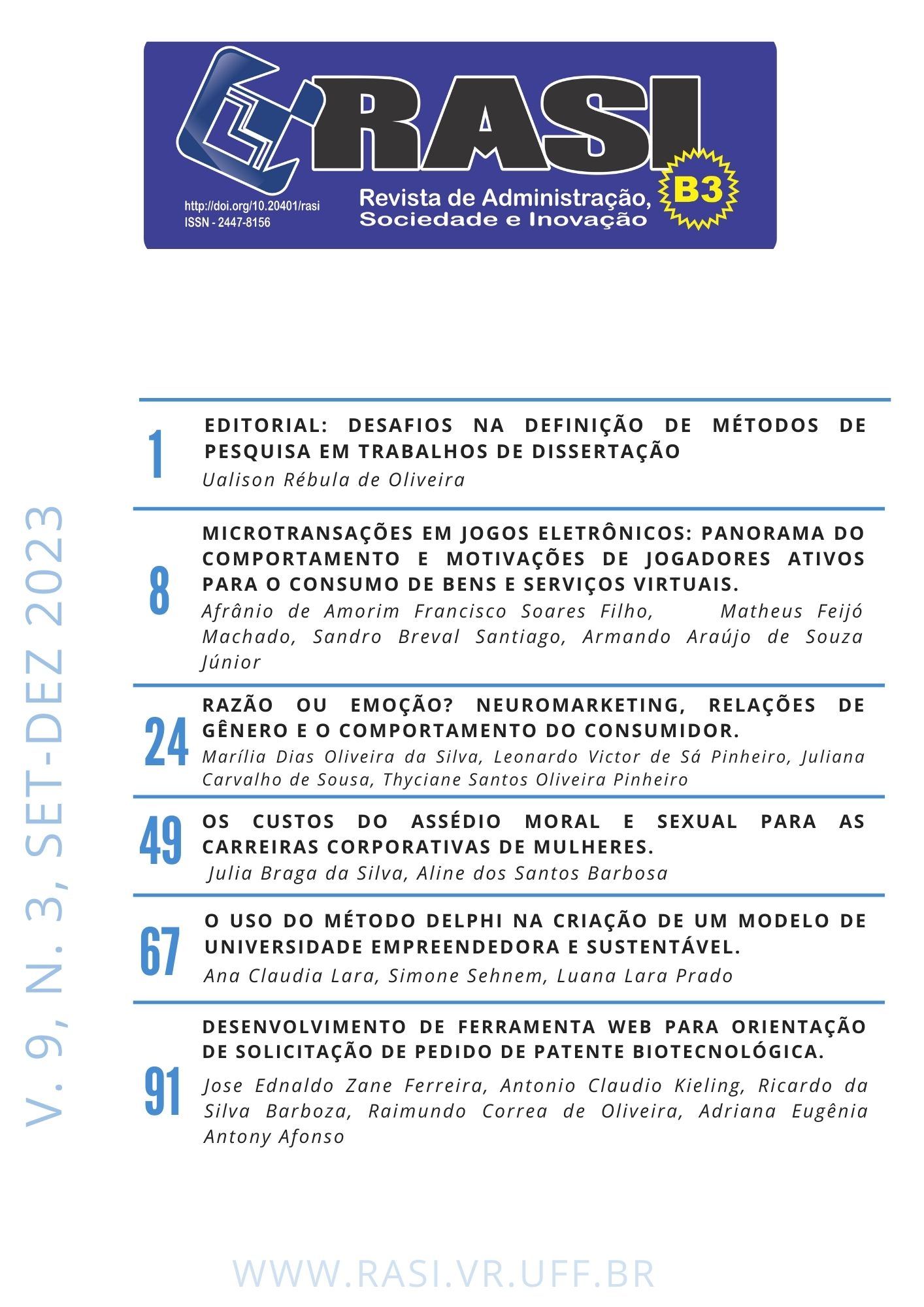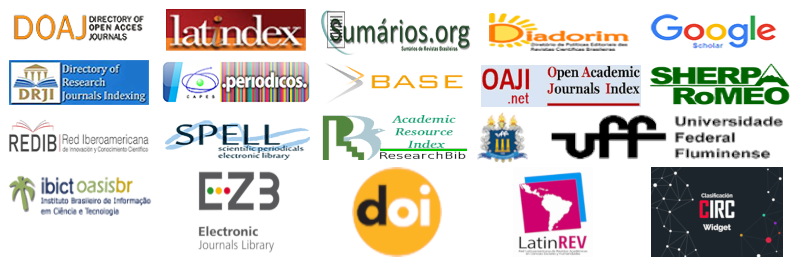Development of a web tool to guide the request for a Biotechnological Patent Application
DOI:
https://doi.org/10.20401/rasi.9.3.784Keywords:
Desenvolvimento web;, Pesquisa;, Propriedade Intelectual;, Pedido de PatenteAbstract
This technological article addresses the planning and development of a website and aims to present the step-by-step process to apply for a patent application at the National Institute of Intellectual Property (INPI). It is configured as the second stage of a research that resulted in the need to plan a web tool for guidance on how to file a patent application. The research adopted an exploratory methodology, as it seeks to solve a problem. With the result of this research, the steps taken for the elaboration and development of a website type product were presented to guide about the necessary steps to carry out the deposit of a Patent application at the INPI, since the institute's website has a comprehensive subject and more complex manuals. , causing a time-consuming reading and requires more time to understand. The product of this technological research was registered on the website "registro.br'', and as it is a website it is not a patentable product, its legal security lies in the registration and ownership of the domain www.inovamazompi.com.br.
Downloads
References
BASSO, Maristela. O direito internacional da propriedade intelectual. Porto Alegre: Livraria do Advogado, 2000.
BARRAL, W.; PIMENTEL, L. O. Propriedade intelectual e desenvolvimento. Florianópolis: Fundação Boiteux, 2007. 447 p. ISBN 8587995774.
BARBOSA, D. B. Uma introdução à propriedade intelectual. Segunda Edição Revista Atualizada. 2010.
BRASIL, LEI Nº 9.279, DE 14 DE MAIO DE 1996. Disponível em https://www.planalto.gov.br/ccivil_03/leis/l9279.htm Acessado 21/05/2021.
CERQUEIRA, João da Gama. Tratado de propriedade industrial – Volume I: da propriedade industrial e do objeto dos direitos. 3 ed. Rio de Janeiro: Lumen Juris, 2012.
CHESBROUGH, H. W. Open Innovation: The New Imperative for Creating and Profiting from Technology. Harvard Business School Press. Boston, MA, 2003.
DI BLASI, G. Como o empreendedor deve entender a propriedade intelectual: A importância da proteção de direitos de propriedade intelectual para empreendedores que inovam. Endeavor. 2014. Disponível em: <https://endeavor.org.br/inovacao/como-o-empreendedor-deve-entender-a-propriedade-intelectual/>. Acesso em: 01 set 2021.
GIL, A. C. Como elaborar projetos de pesquisa. 4. ed. São Paulo: Atlas, 2002.
GRAHAM, S. JH; SICHELMAN, T. Why do start-ups patent. Berkeley Technology Law Journal, v. 23, p. 1063, 2008.
LEMOS, Ronaldo. Propriedade Intelectual. Fundação Getúlio Vargas. Rio de Janeiro, 2011. Disponível em http://academico.direito-rio.fgv.br/ccmw/images/2/25/Propriedade_Intelectual.pdf . Acesso em 10 out 2020.
MAYERHOFF, Z. D. V. L. et al. Estudo comparativo dos critérios de patenteabilidade para invenções biotecnológicas em diferentes países. Rio de Janeiro: GTEB/INPI, 2007.
MARCONI, M. A.; LAKATOS, E. M., Fundamentos de metodologia científica. 5. ed. São Paulo: Atlas, 2003.
MENEZES, R.; DALCOMO, G. Due diligence em investimentos de venture capital parte 2: propriedade intelectual. Capital aberto. 2013. Disponível em: < https://capitalaberto.com.br/boletins/vc-e-empreendedorismo-derraik/due-diligence-em-investimentos-de-venture-capital-parte-2-propriedade-intelectual/ > Acesso em: 02/09/2021.
NEVES, P. J. G. das. Gestão da propriedade intelectual nas startups: principais impulsionadores e inibidores ao patenteamento para startups portuguesas. 2015. Dissertação de Mestrado, Universidade de Lisboa. Instituto Superior de Economia e Gestão.
OMPI A Convenção da OMPI está disponível em: < http://www.direitoshumanos.usp.br/index.php/WIPO-World-Intellectual-Property-Organization-Organiza%C3%A7%C3%A3o-Mundial-de-Propriedade-Intelectual/convencao-que-institui-a-organizacao-mundial-da-propriedade-intelectual.html> . Acesso em: 9/07/2021.
PEERBITS. Reasons to choose reactjs for your web development project. [S.I] [2021]. Disponível em: <https://www.peerbits.com/blog/reasons-to- choose- reactjs-for-your- web-development-project.html> Acesso em: 09 dez. 2021.
PRYNGLER, N. Um panorama sobre os desafios do empreendedor brasileiro. In: COUTINHO, D. R; FOSS, M. C.; MOUALLEM, P. S. B. Inovação no Brasil: avanços e desafios jurídicos e institucionais. 1. ed. São Paulo. Blucher Open Access. 2017. p. 242-262.
SILVA, E. L e MENEZES, E. M: Metodologia da pesquisa e elaboração de dissertação. Florianopolis: USFC, quarta ed. 138p.
SUZUKI, H. Inovação, Patentes e Informações Tecnológicas – o que todo mentor, empreendedor e investidor deveria saber. Inovativa Brasil. 2017. Disponível em:
<https://www.inovativabrasil.com.br/inovacao-patentes-startup/>. Acessado em 13 out. 2019.
WIKIPEDIA. React (JavaScript library). [S.I] [2021]. Disponível em: <https://en.wikipedia.org/wiki/React_(JavaScript_library)> Acesso em: 03 dez. 2021.
WIELAND III, C. F.; CUMMINGS, S. W. How successful startups capitalize on IP. IEEE Nanotechnology Magazine, v. 1, n. 2, 2007.
ZUINI, P. Como proteger sua ideia nos Estados Unidos. Pequenas Empresas e Grandes Negócios. 2015. Disponível em: <https://revistapegn.globo.com/Startups/noticia/2015/11/como-proteger-sua-ideia-nos-estados-unidos.html >. Acesso em: 27/08/2021.
Downloads
Published
Issue
Section
License
Copyright (c) 2023 Review of Administration, Society and Innovation

This work is licensed under a Creative Commons Attribution 4.0 International License.
RASI, in accordance with Law No. 9,610 of February 19, 1998, which amends, updates and consolidates Brazilian copyright law and makes other provisions, adopts the following conditions of the Copyright Assignment:
1. RASI maintains, with the transfer of copyrights, the possession of rights over the content published;
2. The author retains his moral rights of the content, including the right to be identified as the author whenever the content is published;
3. Despite the attribution of copyright, the author retains the right to reuse the material in future collections of his own work without encumbrance. The acknowledgments of the previous publication in the RASI are the only requirements in such cases;
4. The author may make photocopies of the content, or distribute it by electronic mail or fax, provided that they are intended for their own classes and for the purpose of meeting research objectives, provided that: (a) such copies are not resold and (b) reference to the original source of the publication and the name of the RASI are clearly indicated on all copies made of the document.











